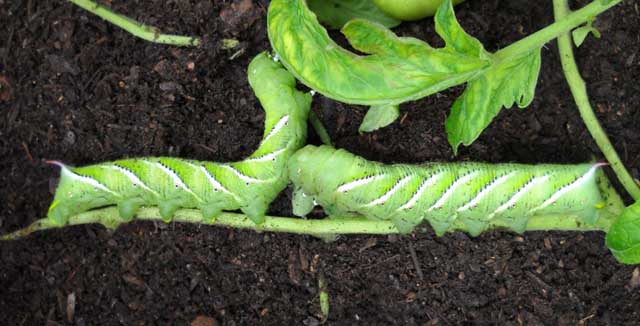
Manduca sexta fifth istar larvae on tomatoes,
Berkeley, Alameda County, California,
August 5, 2011, courtesy of Grace Munakata

I recommended she plant some portulaca to bring in Hyles lineata, and I am very surprised she has not recorded Hemaris thetis on her butterfly bush, but they do look quite a bit like large bees!.
Grace has taken the time to observe and document the excavation of tunnels and burrowing of the larvae.
She writes, "A friend gave me six huge caterpillars yesterday, one of which has already burrowed down. Will put up 1/4" mesh about 30" tall and about 20" wide with a top in case they actually become moths this summer- then will release."
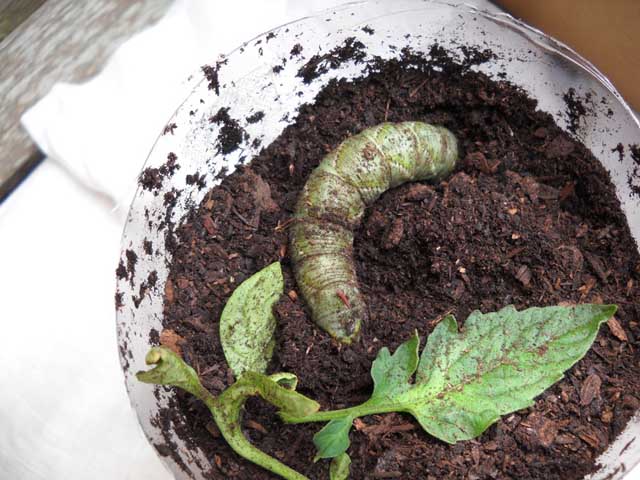
Maduca sexta, mature larva in pupation pot, Grace Munakata.
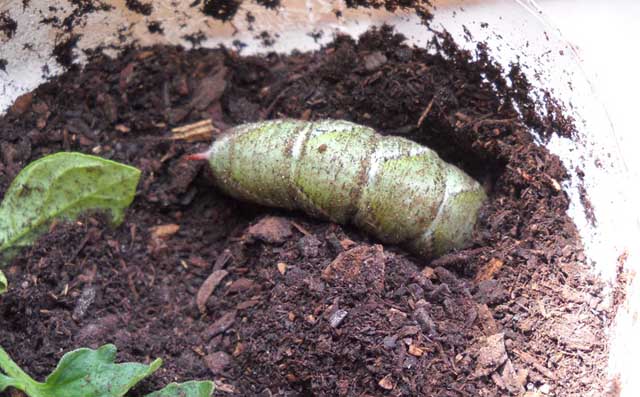
Maduca sexta, mature larva in pupation pot, Grace Munakata.
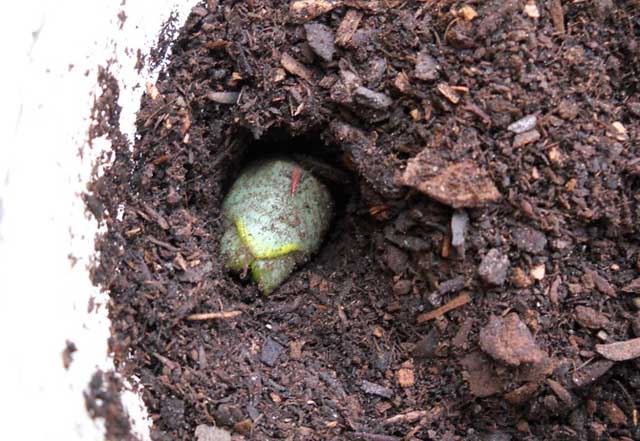
Maduca sexta, mature larva in pupation pot, Grace Munakata.
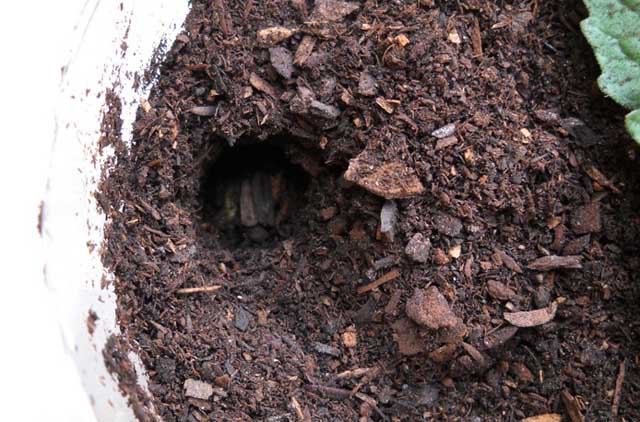
Maduca sexta, mature larva in pupation pot, Grace Munakata.
While it is fascinating to watch the excavation process, attempts to duplicate nature's resources, ie., providing soft earth or pupation medium in which to excavate and pupate, can present some problems.
It is important that the larva remain in a humid environment, but one that is not too wet. Under natural conditions either rain or the upward "wicking" of moisture from the soil below, help to maintain a relatively high humidity in the soil surrounding the pupation chamber. There is also a natural drainage so that the pupa never gets submerged, at least not for any length of time. Unless the pupation pots that Grace has chosen have drainage holes, efforts to keep the medium moist may introduce too much moisture. On the other hand, such holes in the bottom of the pot can cause the medium to dry out rather quickly.
If the moth does emerge from its pupa successfully, it will also need something on which to climb and from which to hang so that it can inflate its wings properly.
A stick inserted into soil without damaging the pupa, or a stick on a diagonal from the medium surface to near the top of the "pot" should also be sufficient.
I actually recommend the method discussed in "For care of "found larvae/caterpillars" visit Manduca sexta larva, central Texas, August 21, 2008, Trina Woodall."
On the other hand, there is much to be learned and appreciated from watching more natural processes.
I was delighted to receive this email note from Grace on April 21, 2012:
"Hi Bill,
"This is Grace from Berkeley. I had six pupae that did not eclose last summer.
I put three in the fridge with the bubble wrap, napkins and tissue covers, and three in a bucket of dirt. One of my nephews, who is a marine biologist
warned me that if the lid was too tight, bacteria in the soil etc. could get them, so I left the pail lid ajar. Then it rained and rained for a few days in February,
and the pail was full of water and mud. I figured I had drowned them, but I cleaned them up and put them in a paper towel with a large houseplant in studio.
Today I noticed one had its lower abdomen sticking up out of the dirt, and it turns out all three are FINE and rotating their back ends.
"We're at about 13.5 hr daylight now, close to what I have read is recommended.
"Put them in a big tupperware that can hold files. Will add the three from fridge, according to your instructions. Would be sooo cool if they emerge, though
not sure what they would nectar on. I have blooming sage, potatoe vine, roses, freesia etc., maybe will plant some petunias. Hope I have good news for You soon!!"
I replied: "Hi Grace,
"They apparently have a remarkable ability to withstand being submerged. I would like permission to post this observation, credited to you to Manduca sexta
page?
"Best of luck with them."
This site has been created by
Bill Oehlke at oehlkew@islandtelecom.com
Comments, suggestions and/or additional information are welcomed by Bill.
TAXONOMY:
Family: Sphingidae, Latreille, 1802 |
MIDI MUSICcopyright C. Odenkirk ON.OFF |
Use your browser "Back" button to return to the previous page.
This page is brought to you by Bill Oehlke and the WLSS. Pages are on space rented from Bizland. If you would like to become a "Patron of the Sphingidae Site", contact Bill.
Please send sightings/images to Bill. I will do my best to respond to requests for identification help.
Enjoy one of nature's wonderments: Live Saturniidae (Giant Silkmoth) cocoons.
 Show appreciation for this site by clicking on flashing butterfly to the left. The link will take you to a page with links to many insect sites. |